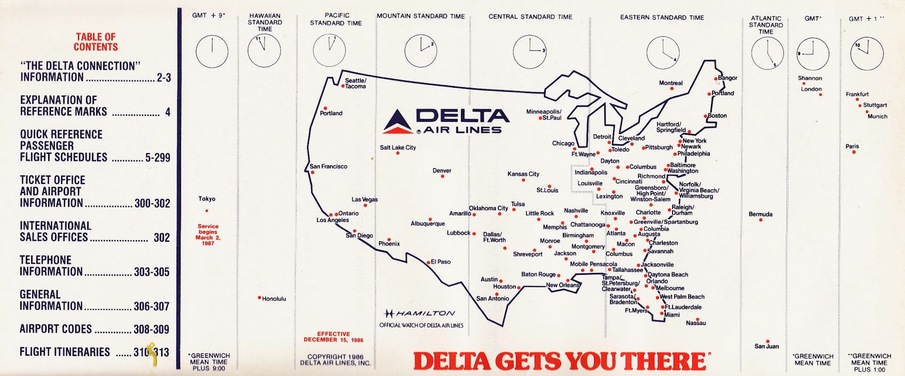

A Look Back At The Origins Of Delta’s Loyalty Programs
I’m beginning work on this article on May 16, 2016. That’s a significant date for everyone that travels on Delta Airlines. Starting today Delta’s stab at an elevated Economy experience (it’s really hard typing that without making a face), called Comfort +™ officially becomes it’s own fare class. This development is causing a lot of confusion for even the most experienced Delta travelers and the online communities are all abuzz with facts, rumors and opinions. Baccarat_guy and I were chatting and we thought there’s no better time to take a step back and provide an in-depth series of articles on how to approach Delta, the SkyMiles program, and their partners & alliances from a fresh perspective. This will be a good reference point for both new and experienced Delta flyers. This first installment will cover the history of Delta’s Loyalty programs and future installments will describe a straight-forward way to begin your collection of Delta SkyMiles, attainment of Elite status, the accelerated earning of SkyMiles and the best way to cash them in for your aspirational trips.
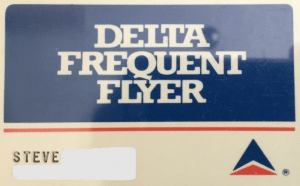

The Beginning Of Delta Airlines’ Frequent Flyer Programs
Delta rolled out it’s first Frequent Flyer Program in 1981. It was a very simple and straightforward program. You joined, got a FF points, flew on Delta and they gave you points equal to the number of nautical miles you flew. They also established a relationship with American Express where the transactions on your American Express card could be converted to Delta FF points. It was very simple back then (sigh). Delta already had an elite status program called Flying Colonel. There was no clearly defined number of miles you needed to accrue or number of dollars you had to spend to become a Flying Colonel. It was a subjective determination that was made at Delta headquarters according to how they defined high value customers during that period. Most of the Flying Colonels were true frequent flyers but sometimes they were high ranking executives at major corporations, well-connected individuals, politicians and celebrities. Delta also created another designation, Flying Orchid, that was typically granted to the wife of the Flying Colonel. (My how things have changed!) The Flying C’s had their computer record annotated with this elite status, and reservation staff, ticket counter workers and gate agents had the ability to exercise their own discretion in granting upgrades (no coupons or certificates required), clearing standby status and dispensing other favors and perks. The Flying C’s also also had a free pass to access Delta’s Crown Room Lounges (now known as SkyClubs). The card actually said “Free Lifetime Crown Room Membership” but that perk has mysteriously vanished.
Medallion: Delta’s First True Elite Status
Early in the 1990’s came out with their first official and quantitatively-based elite status, Delta Medallion Frequent Flyer. To reach this status you had to accrue 40,000 FF miles in a calendar year. They didn’t all have to be BIS (“Butts In Seats”) miles but you had to earn 40,000 of them. With your Medallion status you got a card, some luggage tags and, most important of all, a collection of certificates that you could use to get upgrades to First Class. You could also use these certificates to upgrade from Coach to Business or Business to First Class on International flights. There is a heaven and it’s located at the front of the plane. In the 1990’s, Delta’s International First class offered caviar service, several choices of entrees, truly fine wines, made to order sundaes and gift coupons for on-board duty free shopping that enabled you to get real bargains like a Mont Blanc Pen for $40.
The Delta award charts were pretty simple. Continental United States, US to Alaska or Hawaii, US to Europe, US to Asia and a few other destinations. Two First Class tickets to Hawaii could be had for 80,000 Frequent Flyer miles. Yes, that’s right – T W O First class tickets, US to Hawaii for 80,000 points. Let that sink in. Pretty stellar right? Singapore Airlines was also a partner of Delta’s throughout the 90’s and with a little bit of diligent research, phone skills and being mindful of the calendar 331 days in advance of desired travel dates, you could score 2 First Class tickets from LAX or SFO to Singapore on SQ’s 747 aircraft. Was that a good award? Hey, any airline that asks you if you would like vintage Dom Perignon or Krug as a pre-departure beverage is my kind of airline. (more sighing)
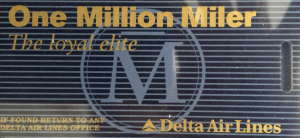

Million Miler – Moving Into The FF Major Leagues
If you were a true frequent flyer and you put in multiple years of more than 100,000 BIS miles every year, the ultimate goal was to achieve Million Miler Status. The movie “Up In The Air” is derived from a book with a similar name. In the movie, George Clooney’s character was going for 10 Million Miles but if you go back and read the original book, the goal was 1 Million Miles. What did you get when you hit 1 Million Miles? The way all of the devoted Deltoids acted you would have thought you received automatic upgrades to first class, a free sports car and your name emblazoned on a personal Delta jet. The reality was nice, but nowhere near that nice. I’ve attached a copy of the nice letter I got from then Chairman, Ron Allen, commemorating my hitting the Million Miler threshold. It came in a nice Delta blue folder, along with some MM luggage tags (pictured above), MM stationary and a gift catalog where I could pick a free gift. I also received “Lifetime” Medallion Status. I put Lifetime in quotes because I used to think that it meant my lifetime, but Delta thinks it means the lifetime of the associated program. The choices then were some Hartman luggage, some items from Tiffany and one or two other things that I can’t recall. Achieving 1 MM was supposed to be the Holy Grail, the summit of Mt. Everest or the crowning achievement of my flying career. Well, it wasn’t. As soon as I got that letter, I started researching how I was going to get 2MM, 3MM or more. Delta had me hooked on miles.
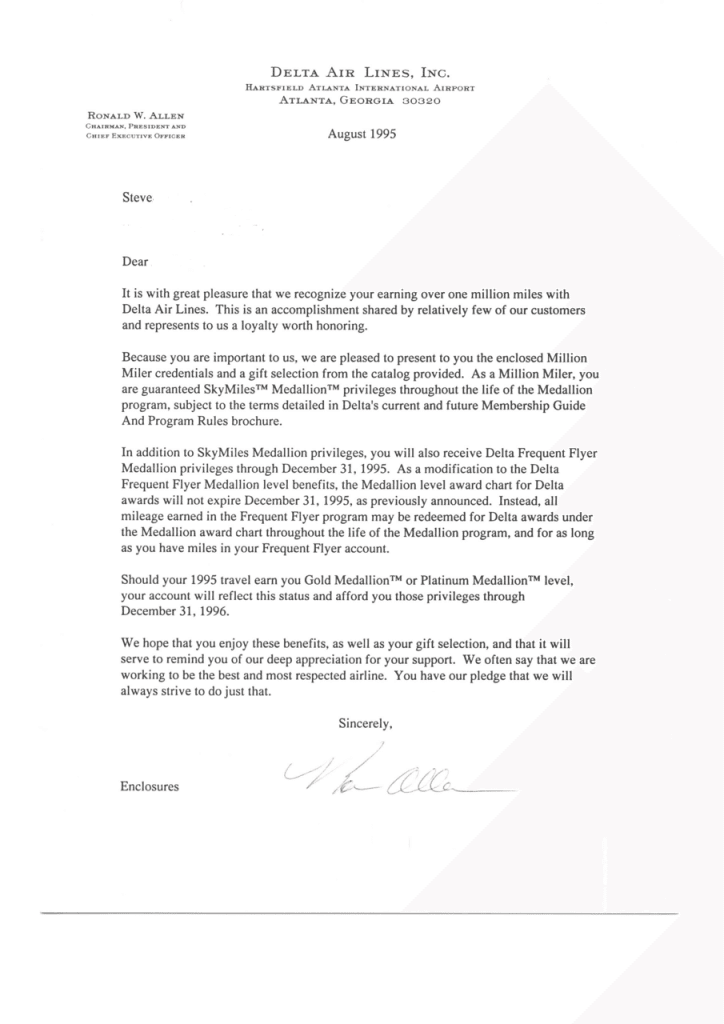

Bye Bye Delta Frequent Flyer Miles, Hello SkyMiles
In 1995, The Delta FF Miles program was sunset and SkyMiles was introduced. Any miles earned under the old FF program would never expire and they could be used to claim awards under the old awards chart, making old Delta FF miles extremely valuable. SkyMiles’ awards were not as generous as FF miles and they would would expire after 3 years if there was no activity in your SkyMiles account. Delta also created 3 Tiers for the SkyMiles program based on what they started to call Medallion Qualification Miles (“MQMs”). MQM were earned primarily through BIS miles but Delta offered special promotions where you could earn MQMs through direct purchase, donations to charity and through the use of co-branded credit cards. The 3 elite levels that carried Delta up until 2010 were:
- Delta Silver Medallion – Minimum of 25,000 MQMs earned in one calendar year
- Delta Gold Medallion – Minimum of 50,000 MQMs earned in one calendar year
- Delta Platinum Medallion – Minimum of 75,000 MQMs earned in one calendar year
Delta also announced that it was creating new “Lifetime” status tiers for Million Milers:
- Achieve 1 Million MQMs – Lifetime Silver Medallion Status
- Achieve 2 Million MQMs – Lifetime Gold Medallion Status
- Achieve 3 Million MQMs – Hmmmmmmm? Nothing special. You do get a gift.
- Achieve 4 Million MQM – Lifetime Platinum Medallion Status
The program rolled along with some additions, deletions, changes and modification up to and through 9/11 and all of the major airline bankruptcies that occurred around 2005.
2009 And Beyond – Delta Acquires Northwest And Things Start Changing And Changing And Changing…
In late October of 2008, Delta merged with Northwest. It was called a merger for financial reasons but in truth Delta acquired Northwest with NW shareholders receiving 1.25 Delta shares for the NW shares. Richard Anderson, the CEO of NW, took over as Delta’s CEO but the Delta brand became the single, unified brand and the Northwest name was retired. After a period of integration, Delta announced the NW WorldPerks program would be folded into SkyMiles program. This event probably increased the number of SkyMiles members by 60-80%. At the beginning of 2011, Delta then announced two significant developments: Delta SkyMiles would no longer expire and they were adding a new, even higher tier to the SkyMiles program, Delta Diamond Medallion. To achieve Diamond status, one would have to achieve 125,000 MQMs in a calendar year. Upgrade priority also was tied to one’s Medallion status so Diamonds outranked Platinums, Platinums outranked Golds and so on. Unfortunately, it wasn’t always that clear cut. A non-medallion Skymiles member on a full-fare coach ticket (Y fare) would get priority for an upgrade over a Diamond on a discounted ticket. As you might imagine that didn’t sit too well with Delta’s devoted and demonstrative Diamonds.
Contrary to popular rumors, I don’t really believe that Delta has a room full of spreadsheet jockeys, actuaries and abacus experts who spend all day T R Y I N G to make life miserable for its customers. It may seem like that given all of the changes that have occurred in the last 3 years but it’s just not true (I keep telling myself if I keep writing it down, it will come true).
In 2014 Delta amended to program to include two new qualifiers for elite tier achievement: Medallion Qualifying Segments (MQSs) and Medallion Qualifying Dollars (MQDs). Achieving SkyMiles Elite status was determined per this chart.
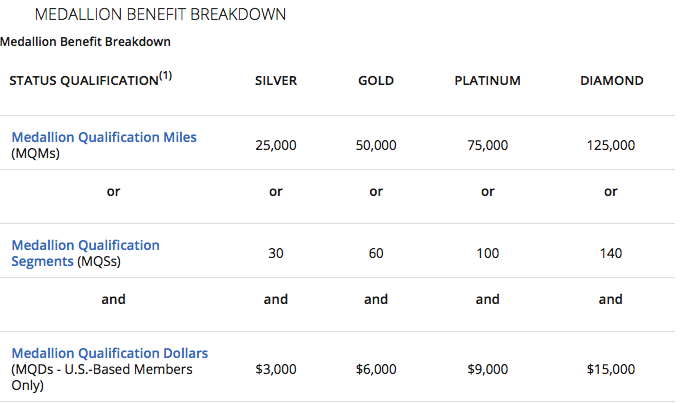

By attaining these levels Delta SkyMiles Elites were entitle to the following flight and program benefits plus fee waivers:
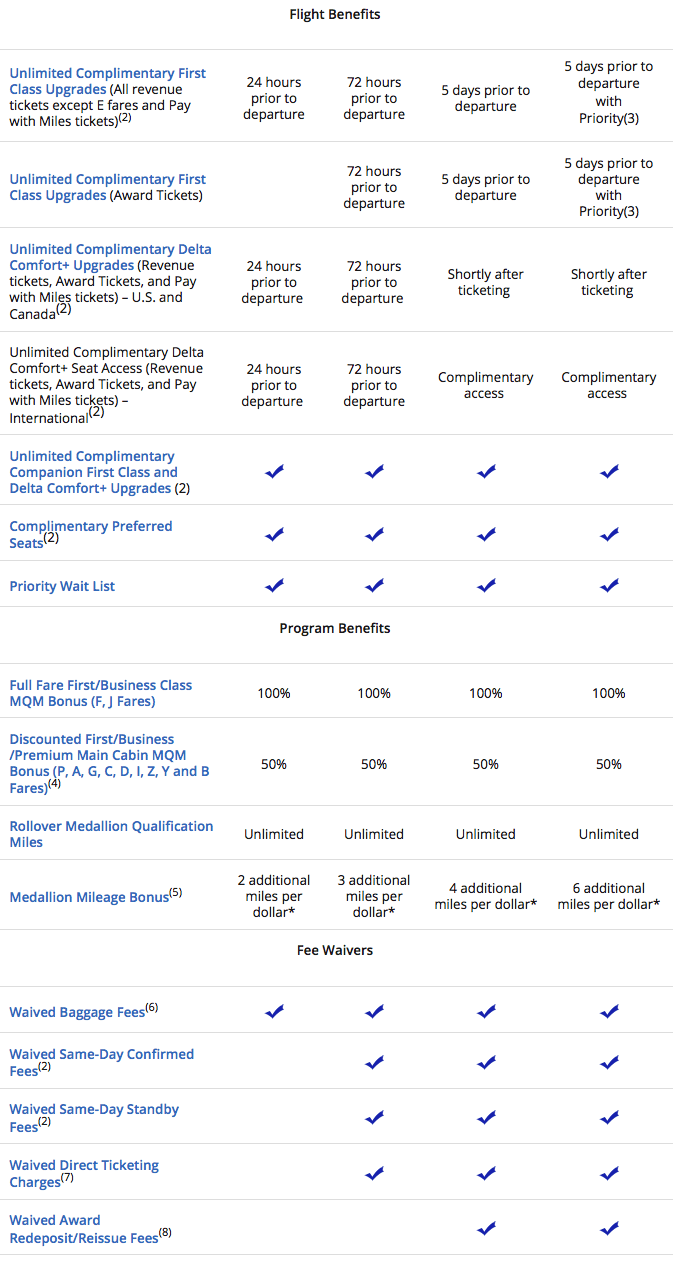

Pay careful attention to the row labeled “Medallion Mileage Bonus(5)” as it will play a major role in helping explain the one of the key values of achieving each tier of Delta SkyMiles Elite status in our future articles. One other item of note: If you exceeded the threshold for one elite tier but did not achieve the next, your MQMs would rollover to the next year. Here’s an example: Say you achieved 95,000 MQMs in 2015. You would have achieved the 75,000 MQMs needed for Platinum status. Along with at least $9,000 in MQDs, you would be granted Platinum status for 2016. You would also have 20,000 MQMs that would rollover into 2016, giving you a head start on your Elite status journey for 2017 qualification.
That brings us up to date on the history of Delta’s Loyalty programs. In the next installment, we’ll start laying out a simple strategy to start you on your way to elite status and free airfares.









